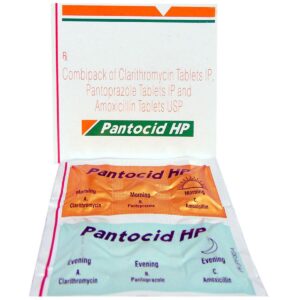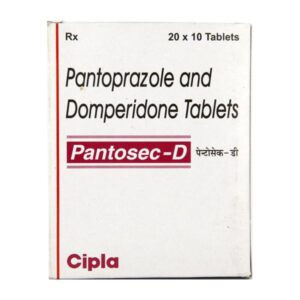PANTOPRAZOLE + DOMPERIDONE
Pantoprazole: Pantoprazole is a medication that belongs to the class of drugs known as proton pump inhibitors (PPIs). It is commonly used to treat conditions that involve excessive stomach acid production, such as gastroesophageal reflux disease (GERD), peptic ulcers, and Zollinger-Ellison syndrome.
The mechanism of action of Pantoprazole involves blocking the enzyme in the stomach wall that produces acid, thus reducing the amount of acid produced. By decreasing the acid levels, Pantoprazole helps to relieve symptoms such as heartburn, regurgitation, and indigestion.
The typical dose of Pantoprazole for treating GERD and peptic ulcers is 40 mg once daily, usually taken before a meal. In the case of Zollinger-Ellison syndrome or other conditions that require higher doses, the dosage may be increased to 80 mg or divided into two daily doses.
Some of the common side effects of Pantoprazole include headache, dizziness, diarrhea, nausea, and stomach pain. It may also cause an increased risk of bone fractures, particularly in individuals who take high doses of the medication for long periods. Rare but serious side effects may include severe allergic reactions, liver problems, and a low level of magnesium in the blood.
It is important to note that Pantoprazole may interact with certain medications, so it is essential to inform your healthcare provider about all the medications you are taking to avoid any potential interactions. Additionally, long-term use of Pantoprazole can lead to an increased risk of infections, as it reduces the normal protective acid levels in the stomach.
Domperidone: Domperidone is a medication used to treat various gastrointestinal disorders such as nausea and vomiting. It is also commonly prescribed to increase and regulate milk production in lactating women.
The drug works by blocking dopamine receptors in the brain, specifically in the chemoreceptor trigger zone. This action inhibits the neurotransmitter dopamine from binding to these receptors, resulting in the reduction of nausea and vomiting. Domperidone also increases the movement or motility of the stomach and intestines, which helps to regulate digestion.
The usual recommended dose of domperidone for adults is 10-20 mg taken three to four times a day, before meals and at bedtime. The drug is typically taken orally as tablets, but it is also available in the form of suspension or suppositories.
Like any medication, domperidone may have side effects. Common side effects include headache, dizziness, dry mouth, diarrhea, and abdominal cramps. These side effects are usually mild and temporary. In rare cases, more serious side effects like irregular heartbeat, allergic reactions, movement disorders, and increased levels of prolactin hormone may occur. If any severe side effects occur, it is important to seek medical attention immediately.
It is important to note that domperidone is associated with a rare but serious side effect called QT prolongation, which can potentially lead to a life-threatening irregular heart rhythm. Due to this risk, the use of domperidone has certain restrictions and is contraindicated in individuals with underlying heart conditions or taking certain medications that can increase the risk of QT prolongation.
Additionally, domperidone has been associated with an increased risk of a movement disorder called tardive dyskinesia, especially in elderly patients or those taking the medication for an extended period of time. However, this side effect is rare.
It is always essential to consult a healthcare professional or pharmacist before starting or stopping domperidone, and to inform them about any other medications or health conditions an individual may have to ensure safe and effective use of the drug.



